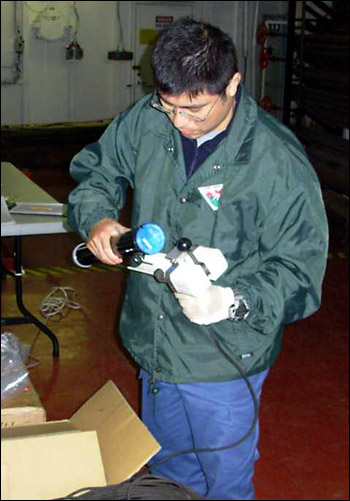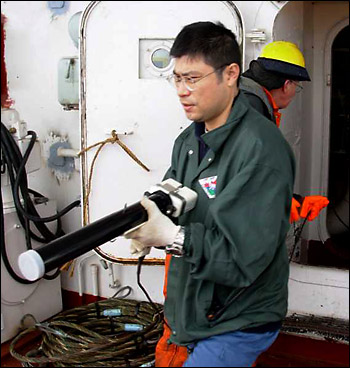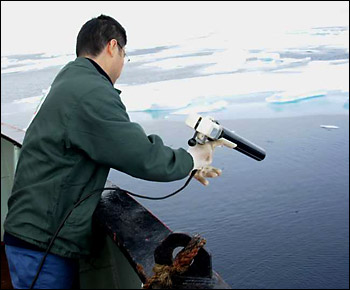Please note: You are viewing
the unstyled version of this website. Either your browser does not support CSS
(cascading style sheets) or it has been disabled. Skip
navigation.
Shigeto Nishino, JAMSTEC
One advantage of the XCTD observation is the short amount of ship time that it takes to make a measurement (compared to a CTD rosette cast which takes several hours). Consequently, it is suitable to capture fine scale ocean structure between CTD casts, such as mesoscale eddies and frontal boundaries. Sometimes, the XCTD is also a powerful tool for a preliminary survey for the CTD (which measures not only temperature and salinity but also oxygen, turbidity, and fluorescence in the sea water). The XCTD data may suggest the best location where a CTD cast should be conducted. Combining the XCTD with the CTD observations, we investigate ocean circulation and water mass distributions to understand the relationships of those variables to recent climate change, which appears to be most prominent in the Arctic region. Recent sea ice retreat in summer in the Pacific sector of the Arctic Ocean could be related to the inflow of warm water that originates from the Pacific and enters via the Bering Strait. Furthermore, this so-called Pacific Water carries nutrients to the Arctic Ocean, and therefore, influences the Arctic ecosystem. Cold water formed in winter in polynya (open water) regions of the Arctic shelf sinks into the deep basins accompanied by the transport of nutrients and carbons, which are important for biogeochemical element cycles (biogeochemistry describes the interactions between biological primary production, ocean chemistry, and geological particle deposition). In addition, a significant warm anomaly of Atlantic water has been observed in the Canada Basin far from the Fram Strait source where the Atlantic water flows into the Arctic Ocean. Scientists from JAMSTEC have been conducting XCTD surveys (and other work) from the Louis (and other vessels) over the past several years to address these issues in collaboration with IOS/DFO under the JWACS (Joint Western Arctic Climate Studies) project. Last updated: October 7, 2019 | |||||||||||||||||||
Copyright ©2007 Woods Hole Oceanographic Institution, All Rights Reserved, Privacy Policy. | |||||||||||||||||||





